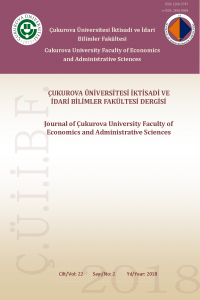Öz
Günümüzde işletmeler
artan rekabete uyum sağlayabilmek ve müşterilere daha hızlı cevap verebilmek
için geleneksel üretim yöntemlerinin dışına çıkmak zorunda kalmaktadır. Üretkenliği
arttırmak için benzer parça ve makinelerin bir araya getirilmesi felsefesine
dayanan grup teknolojisi birçok işletme tarafından yaygın bir şekilde kullanılmaktadır.
Hücresel imalat yaklaşımında, parçalar, tasarım ve imalat açısından benzerliklerine
göre gruplandırılıp parça aileleri haline getirilirken, makineler ise iş akışına
göre hücrelerde gruplandırılmaktadır. Böylece, hazırlık zamanları ve ara
stoklardaki yığılmalar azalarak, üretim planlama ve çizelgelemede etkinlik
artışı gözlenmektedir. Bu da üretimde verimliliği sağlar. Yapılan çalışmada,
hat akışı üretim sistemine sahip olan bir mobilya fabrikasının taşımalardan
kaynaklanan kayıplarını önlemek ve üretimde verimliliği artırmak amacıyla
hücresel imalata geçiş için bir ön hazırlık yapılmıştır. Fabrikada makine
grupları, parça aileleri ve hücre oluşum problemi üzerinde durulmuştur. Grup
etkinliğini sağlamayı hedefleyen bir matematiksel model yardımıyla problem
çözümlenmeye çalışılmıştır. Matematiksel model sonuçlarının mevcut durum ile
karşılaştırılması yapılarak, firmaya önerilerde bulunulmuştur.
Anahtar Kelimeler
Kaynakça
- Chandrasekharan, M. P., & Rajagopalan, R. (1989). GROUPABILITY: an analysis of the properties of binary data matrices for group technology. The International Journal of Production Research, 27(6), 1035-1052.
- Suresh Kumar, C., & Chandrasekharan, M. P. (1990). Grouping efficacy: a quantitative criterion for goodness of block diagonal forms of binary matrices in group technology. International Journal of Production Research, 28(2), 233-243.
- Hsu, C.P. (1990). Similarity coefficient approaches to machine-component cell formation in cellularmanufacturing: a comparative study. Ph.D. Thesis, Department of Industrial and ManufacturingEngineering, University of Wisconsin Milwaukee.
- Islam, K. M. S., & Sarker, B. R. (2000). A similarity coefficient measure and machine-parts grouping in cellular manufacturing systems. International journal of production research, 38(3), 699-720.
- Albadawi, Z., Bashir, H. A., & Chen, M. (2005). A mathematical approach for the formation of manufacturing cells. Computers & Industrial Engineering, 48(1), 3-21.
- Mahdavi, I., Javadi, B., Fallah-Alipour, K., & Slomp, J. (2007). Designing a new mathematical model for cellular manufacturing system based on cell utilization. Applied Mathematics and Computation, 190(1), 662-670.
- Krushinsky, D., & Goldengorin, B. (2012). An exact model for cell formation in group technology. Computational Management Science, 1-16.
- Shiyas, C. R., & Pillai, V. M. (2014). A mathematical programming model for manufacturing cell formation to develop multiple configurations. Journal of Manufacturing Systems, 33(1), 149-158.
- Bychkov, I., & Batsyn, M. (2018). An efficient exact model for the cell formation problem with a variable number of production cells. Computers & Operations Research, 91, 112-120.
Öz
Today, businesses are forced to go beyond
traditional production methods in order to be able to adapt to increasing
competition and respond to customers faster. Group technology based on the
philosophy of bringing together similar parts and machines to increase
productivity is widely used by many businesses. In the cellular manufacturing
approach, the parts are grouped according to their similarities in terms of
design and manufacturing and turned into part families, while the machines are
grouped into cells according to work flow. Thus, setup times and stacks in
buffer stocks are reduced while efficiency increase in production planning and
scheduling is observed. This also ensures the efficiency in production. In this
study, a preliminary work was made for the transition to cellular manufacturing
in order to prevent losses caused by the transportation of a furniture factory
having a line flow production system and to increase efficiency in production.
Machine groups, parts families and cell formation problem are discussed in the
factory. The problem has been tried to be solved using a mathematical model
which aims to provide the group efficiency. Mathematical model results were
compared with the current situation and suggestions were made to the firm.
Anahtar Kelimeler
Kaynakça
- Chandrasekharan, M. P., & Rajagopalan, R. (1989). GROUPABILITY: an analysis of the properties of binary data matrices for group technology. The International Journal of Production Research, 27(6), 1035-1052.
- Suresh Kumar, C., & Chandrasekharan, M. P. (1990). Grouping efficacy: a quantitative criterion for goodness of block diagonal forms of binary matrices in group technology. International Journal of Production Research, 28(2), 233-243.
- Hsu, C.P. (1990). Similarity coefficient approaches to machine-component cell formation in cellularmanufacturing: a comparative study. Ph.D. Thesis, Department of Industrial and ManufacturingEngineering, University of Wisconsin Milwaukee.
- Islam, K. M. S., & Sarker, B. R. (2000). A similarity coefficient measure and machine-parts grouping in cellular manufacturing systems. International journal of production research, 38(3), 699-720.
- Albadawi, Z., Bashir, H. A., & Chen, M. (2005). A mathematical approach for the formation of manufacturing cells. Computers & Industrial Engineering, 48(1), 3-21.
- Mahdavi, I., Javadi, B., Fallah-Alipour, K., & Slomp, J. (2007). Designing a new mathematical model for cellular manufacturing system based on cell utilization. Applied Mathematics and Computation, 190(1), 662-670.
- Krushinsky, D., & Goldengorin, B. (2012). An exact model for cell formation in group technology. Computational Management Science, 1-16.
- Shiyas, C. R., & Pillai, V. M. (2014). A mathematical programming model for manufacturing cell formation to develop multiple configurations. Journal of Manufacturing Systems, 33(1), 149-158.
- Bychkov, I., & Batsyn, M. (2018). An efficient exact model for the cell formation problem with a variable number of production cells. Computers & Operations Research, 91, 112-120.
Ayrıntılar
| Birincil Dil | Türkçe |
|---|---|
| Bölüm | Araştırma Makaleleri |
| Yazarlar | |
| Yayımlanma Tarihi | 30 Aralık 2018 |
| Gönderilme Tarihi | 13 Mart 2018 |
| Kabul Tarihi | 14 Aralık 2018 |
| Yayımlandığı Sayı | Yıl 2018 Cilt: 22 Sayı: 2 |


